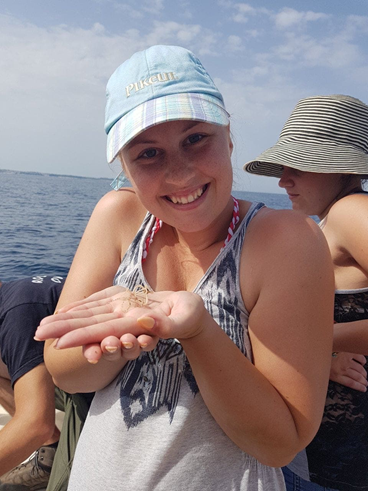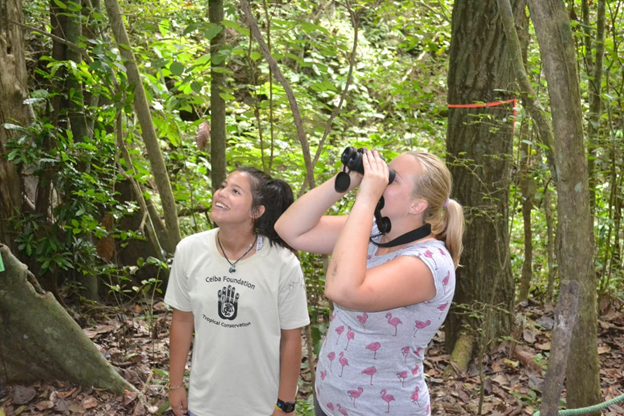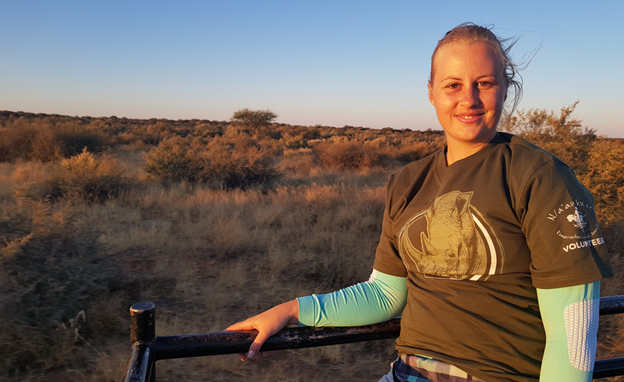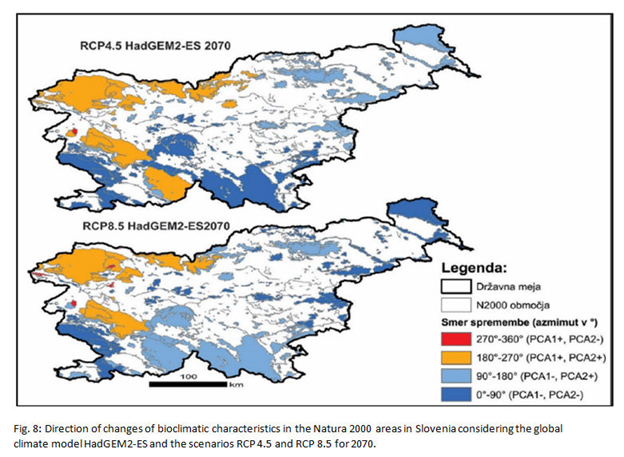- Home
- :
- All Communities
- :
- User Groups
- :
- Conservation GIS
- :
- Documents
- :
- Daša Donša, Slovenia
- Subscribe to RSS Feed
- Mark as New
- Mark as Read
- Bookmark
- Subscribe
- Printer Friendly Page
Daša Donša, Slovenia
Daša Donša, Slovenia
Daša Donša, The Faculty of Natural Science and Mathematics
2020 Scgis International Committee Conservation Software Honoree
MSc student of Biology and Ecology with Nature Conservation; (I also work as project technical staff on a project at our faculty)
(Photos & Maps courtesy of Daša Donša)
Address: Fakulteta za naravoslovje in matematiko, Koroška cesta 160, 2000 Maribor, Slovenija
Main website Main email RESEARCHGATE PROFILE
x2020 x2020International x2020Talk xInternational xEurope xSlovenia xBiodiversity xEducation xMammal xPark xClimate xLandscape xRemote xWildlife xEcology xEnforcement xStatistics xAnalysis
2020 Honoree Introductory Video
Since I started doing my environmental studies, I feel that international cooperation is the best way to acquire new knowledge, that can later be used in your personal work. This is the reason I travel every time I get a chance, because this is the only way to truly understand the way of nature. I am inspired every time I meet someone from a foreign country, through sharing experience with other, same-minded people. As a biology and ecology student, I learned that natural processes go beyond international borders. The SCGIS experience would bring me additional GIS expertise that will stay with me for life. My main goal in life is to contribute to  nature conservation, and I am convinced that trough geospatial data analysis we can make a step further to solving regional or global problems, such as climate and biodiversity crisis, and unsustainable use of resources. SCGIS training and attending the conferences would be a significant part of my CV, which could contribute to getting a good researcher position at the faculty. An opportunity like this is making the difference for young people, to gain as much knowledge as possible through student years, which would allow me to start with serious research work as soon as I finish my studies. Through your course, I desire to meet people with similar interest as mine, which would truly be inspiring for my future work, in view of great minds think alike. I am planning to spread my gained abilities to my work colleagues and younger students that are seeking GIS education, through different project and study courses. One of my main motivation to join your program is learning from the best researches in the GIS field on a global scale. Being able to present my own work on SCGIS Annual Conference in ESRI User Conference is a dream come true!
nature conservation, and I am convinced that trough geospatial data analysis we can make a step further to solving regional or global problems, such as climate and biodiversity crisis, and unsustainable use of resources. SCGIS training and attending the conferences would be a significant part of my CV, which could contribute to getting a good researcher position at the faculty. An opportunity like this is making the difference for young people, to gain as much knowledge as possible through student years, which would allow me to start with serious research work as soon as I finish my studies. Through your course, I desire to meet people with similar interest as mine, which would truly be inspiring for my future work, in view of great minds think alike. I am planning to spread my gained abilities to my work colleagues and younger students that are seeking GIS education, through different project and study courses. One of my main motivation to join your program is learning from the best researches in the GIS field on a global scale. Being able to present my own work on SCGIS Annual Conference in ESRI User Conference is a dream come true!
My organization is University of Maribor (Slovenia), more precisely the Faculty of Natural Science and Mathematics in Maribor. We are the leading regional institute in fields Biology, Ecology, Mathematic, Physic, Educational sciences, Environmental studies, Chemistry and Technical studies. The faculty has many different study courses in these fields and is also strongly encouraging research. The faculty’s vision is to give young students quality education and to encourage them to help solve global, regional or local problems through research. I am actively involved in the Department of Biology, where I help in the GIS research center. Our main research topics are focused in landscape ecology, geoinformatics, conservation ecology, bio- and geo-diversity. Currently we are running a project called “Preventing heat stress in urban systems”, where we aim to understand interactions between climate change and the specific city microclimate, and also help communities to reduce the heat island effect and therefore improve their living and health conditions.

I started studying in 2015 as a bachelor’s degree student of Ecology and nature conservation. I got my bachelor’s diploma in 2018, and in the same year I involved in master’s degree at the same faculty. I am planning to get my master’s degree and finish this level of education next year (2020). In 2018, I was working on a project “On a creative way to knowledge: Developing and evaluating a tool to support agri-environmental climate payments” in which I started more serious work in GIS. On this project I was collecting field data, which I used to make maps, that show where are important areas for conservation and for applying European environmental climate payments. This year (2019) I started working as a scientific project technical stuff at the Department of Biology on a project called “Preventing heat stress in urban systems”, which focus is also in GIS. I am helping with data collection on field and with processing data in GIS.

History of your personal work in conservation and GIS?
My GIS training begun in bachelor’s degree program (Ecology and nature conservation), where we had GIS as one of the mandatory subjects. Because of my good grade in that subject I was invited to work on a project called “On a creative way to knowledge: Developing and evaluating a tool to support agri-environmental climate payments”. In my master’s degree we had one more subject called Landscape ecology, where we processed models of species distributions, light pollution, changes in land use and similar thematic in GIS. In the end of year 2018,
I was always passionate about nature conservation and I wanted to do more than just study and do my mandatory exams, because as a biology and ecology student I feel that only going to university is simply not enough. Therefore, I started working abroad as a volunteer. My first volunteering was in Costa Rica, where I was doing nature conservation work in Animal rescue center, for two months (summer of 2017). The following year (2018) I went to Namibia for 1 month, to work at Animal rescue sanctuary N/a’an ku sê. This year (summer of 2019) I was in Ecuador for two months, working as an intern on different projects in Lalo Loor Dry Forest Reserve, where I was introduced to GIS corridor planning for native animal species in a fragmented landscape. Through my abroad experiences I realized how important and useful GIS tools are in different areas of nature conservation work. Every year when I got back home, I was more enthusiastic about learning GIS at my faculty, which brought me the opportunity to work on a scientific GIS-based project.
As an active conservationist, I am also involved in different local conservation societies. For the past three years, I have been a volunteer in DOPPS-BirdLife Slovenia, which is the biggest nature conservation non-governmental organization in Slovenia and is focusing on protection of different species of birds and their natural habitats. They are the main connection between conservation work and the general public in Slovenia. I am also an active member and former president of DŠN (Students association of natural sciences), which is based in our faculty. Our aim is to encourage young students to be active conservationists. We organize monthly lectures, workshops, field work and summer camps. In both societies, I try and involve GIS as much as possible.
In 2018 I got my first scientific article publish, as a coauthor, in Journal for Geography (local journal at University of Maribor), with the title “The magnitude of climate change in Natura 2000 areas in Slovenia”. (ResearchGate Link😞
Title: The magnitude of climate change in Natura 2000 areas in Slovenia
Authors: Dr. Danijel Ivajnšič, Daša Donša
Abstract: Europe has the world's largest network of protected areas. Of course, climate change affects these areas no less than others. However, scientists reported that forecasts on maintaining climatic suitability for species of European concern in some Natura 2000 areas across Europe are even worse compared to surrounding unprotected areas. From the Slovenian perspective, the most climate change exposed Natura 2000 areas, according to current forecasts, can be found in the Sub-Mediterranean or Sub-Pannonia regions. More stable bioclimatic conditions, as expected, are estimated in the uplands. Such studies, which offer an objective assessment of the impact of climate change in the area, are of immense importance to managers and decision-makers in protected areas in order to prepare and potentially implement mitigation measures on the relevant vulnerable areas.


Currently I am involved in the project “Preventing heat stress in urban systems”, which is based on geospatial data and GIS analysis.


Teaching Interests?
For the past 2 years I have been a tutor of biology and ecology study programs. Through this position I am helping my colleagues and younger students with different subjects and problems, that they are facing in their studies. Every semester I help students prepare for final exam of their GIS subject. A lot of times I am present at GIS exercises at our faculty, where I help professors to teach students about different workflows and problem solving in GIS. This work is very educational for me, because every time I face a new problem which I must solve, also I am learning how to present GIS to total beginners in the simplest way possible. This way am I forced to rethink everything I already know, which is great for reinforcing my knowledge. In the near future I will start helping in GIS beginners and advanced courses, which will be held at my university. For the last two years I had multiple presentations and speeches about my conservation work abroad, through which I tried to spread awareness about wildlife and nature protection. Those presentations were done through DOPPS and DŠN societies and were open to the general public. In school year 2018/2019 I was the president of Students association of natural sciences at my faculty. This was great learning experience, I gained a lot of organization, managing and leading skills. I was responsible for organizing monthly activities, such as lectures or fieldwork, on different thematic. I always tried to incorporate conservation to our activities. Further, I had to organize people to do different tasks in society and prepare monthly meetings, where we discussed our work. From these activities I learned how to collaborate different characters and ideas. I am trying to use my knowledge gained abroad and in faculty in everyday life, and pass it to people around me, so together we can make a better future.

What is the most unique and the most challenging about the conservation/GIS work that you do:
My work is heavily linked to the GIS technology because of the spatial nature of the environmental problems I am interested in. Products in the form of interactive maps are of crucial importance for environmental planners and decision makers who are able to implement our finding and suggestions, which are objectively determined and have a scientific background. Spatial decision support systems could play a key role in future nature protection actions and implementations, therefore geospatial data and spatial analysis techniques are getting more and more attention in many scientific fields that are investigating the changing natural or men-made environments. The difficult part of developing high quality GIS applicable outputs is finding, identifying and collecting appropriate geospatial data sets. We usually have a lack of high spatial resolution socio-economic data, which are typically linked to political units, which are much larger than the spatial resolution of remotely sensed physical indicator datasets. However, in order to develop complex models that consider both aspects of the environment (natural and anthropogenic) and thus better predict spatial processes and patterns in the cultural environment, we still have to bridge many gaps. In one of my research projects, I am trying to explain the existing spatial pattern of the thick-borne diseases in Slovenia. As mentioned below, Slovenia is one of the most infected countries with thick-borne diseases, thus my main goal is to develop a model with whom we can predict the potential spatial distribution in the forthcoming warmer climate and also develop a decision support system in the form of a mobile app to inform users where they are extremely exposed to a higher infection risk in Slovenia.
Current GIS interests:
I have been working with geospatial data (raster and vector) and GIS software for four years, but I still have a lot to learn. However, I gained some experiences in the ArcGIS and TerrSet environment. I know how to use Maxent and MGWR software for modeling species niches and distributions. I am also familiar with the QGIS environment. I am used to work with different global climate models and other environmental datasets for predicting past and future species distributions and spatial range pattern changes. I have experience with TerrSet’s Earth Trends Modeler tool and the CurveFit software, which enable spatial trend analysis. From that perspective, I have worked with geospatial climate data to observe the spatio-temporal dynamics of the ENSO and NAO atmospheric-ocean phenomenons, trends in global sea surface temperature, salinity and pH values and thus evaluated potential threats to currently existing coral reefs. I understand some key spatial statistics methodological approaches like the Principal Component Analysis and Change Vector Analysis. I am also familiar with corridor planning techniques by considering different environmental drivers for the investigated species.
Currently, I am learning GIS through my work on a scientific project “Preventing heat stress in urban systems” which deals with remotely sensed datasets (satellite and LIDAR derived) and “in-situ” geospatial measurements to evaluate the magnitude and development of the urban heat island phenomenon in different sized cities during more and more frequent heatwave periods. The main source of my GIS knowledge are my university professors, but I also learned a lot of workflows by myself, trough tutorials on internet. Through my university study course, I try to work in GIS as much as possible, always finding a way to incorporate GIS in different subject, mainly through seminar work, presentations and individual research work. In my free time I read scientific articles in which authors used GIS. I also train myself by applying different GIS exercises that are accessible online.
I would like to learn more about geospatial modeling, spatial trend analysis, lidar data analysis and geostatistics in general. I am interested in biodiversity and climate change problems, and how to prepare maps for proper mitigation and adaptation measures for a wider audience. So, in near future I want to learn how to represent spatial data to people with different backgrounds of education, landscape planning and management.
2020 Conference paper title:
Modeling the tick-borne disease geospatial pattern in Slovenia
Abstract / summary:
This paper is a part of my master’s degree final dissertation, which is not finished yet. The motivation for this topic originates from the fact, that Slovenia is one of the highest-ranking countries with incidence of tick-borne diseases in Europe, including tick-borne encephalitis and Lyme disease. The aim of this paper is to determinate which of the environmental variables, such as land cover, annual temperature, relative humidity, vector species, climate variables and other, are the main reason for the current spatial pattern of the mentioned tick-borne diseases. Based on correlations made, we will try to predict future distributions of these diseases in Slovenia, which may be significant for general public health and infectious disease awareness.